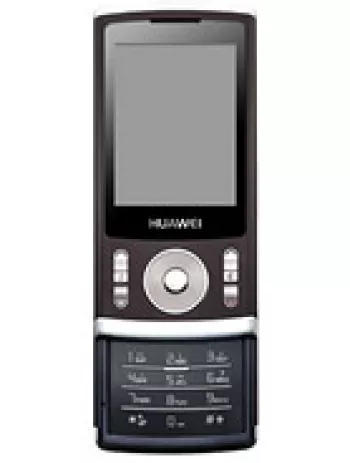
Overview of Huawei U3100
Huawei U3100 is a feature phone released in 2010, now discontinued, yet it remains a noteworthy device from the era of simpler mobile phones. Its basic functionalities make it appealing for those seeking reliability over complexity. With fundamental features like calling, SMS, a basic camera, and more, this device was suited for those seeking functionality over the additional offerings of a smartphone.
Design and Body
The Huawei U3100 is compact and lightweight, with dimensions of 106 x 46 x 13 mm and weighing just 90 g. Its petite size allowed it to fit comfortably in a pocket or bag, and its build was sturdy considering its era. The device supports a Mini-SIM card, a standard at the time of its release, and was available in black, which gave it a sleek and professional look.
Display
The display size of the Huawei U3100 is 2.0 inches, adequate for viewing texts, calls, and basic multimedia. The TFT screen could display 256K colors, which was quite sufficient for typical phone usage at that time. With a resolution of 240 x 320 pixels and a ~200 ppi density, the screen offered clear and visible content albeit with some limitations in bright lighting conditions.
Network and Connectivity
In terms of network capabilities, the Huawei U3100 supports both GSM and UMTS technologies, providing connectivity across 2G and 3G bands. It supports GSM 900 / 1800 / 1900 in 2G bands and UMTS 2100 in 3G, with speeds available up to 384 kbps. The phone had Bluetooth 2.0 with EDR, but no WLAN support. Its USB connectivity was via a miniUSB 2.0 port, allowing for basic data transfer and charging.
Battery Life
The phone is powered by a removable Li-Ion 1000 mAh battery. This battery offers a stand-by time of up to 400 hours and talk time of up to 4 hours and 20 minutes. This battery life was satisfactory for most feature phone users, who typically engaged in less intensive tasks compared to smartphone users.
Camera Features
On the camera front, the Huawei U3100 features a VGA camera, adequate primarily for taking basic photos without high expectations for quality. The presence of video capability was a useful addition, even though the quality was in line with what you'd expect for the 2010 technology era. The selfie camera feature was minimal, but present, marking an early inclusion of this functionality in mobile devices.
Memory and Storage
The internal memory of the Huawei U3100 is 10MB, which, by today’s standards, is quite limited. However, this was typical for many feature phones at the time. It supported microSDHC cards, allowing users to expand storage for applications and files, adding versatility to handle more than its built-in storage could accommodate.
Audio and Multimedia
Sound-wise, the phone included a loudspeaker but did not feature a 3.5mm jack, which was somewhat limiting for audio accessories. It did come with FM Radio functionality, a popular feature for entertainment. Basic support for games, along with Java functionality, allowed users to install and enjoy simple applications.
Messaging and Apps
The Huawei U3100 supported SMS (in a threaded view), MMS, Email, and Instant Messaging, enabling multiple communication channels. The browser supported HTML, offering users a simplified means of accessing the Internet. The phone's Java compatibility allowed for additional app downloads, broadening its usability beyond pre-installed applications.
Usage and Utility
While simple when compared to modern smartphones, the utility of the Huawei U3100 should not be underestimated. It served its purpose well during its market presence, providing an effective means of communication and basic connectivity. Its long battery life and sturdy design made it a reliable choice, especially for those who preferred a straightforward mobile experience.
Conclusion
Overall, the Huawei U3100 retains its place in the nostalgia of early 2010s mobile phones. It highlighted Huawei's ability to create practical yet efficient feature phones before the smartphone revolution took full hold. For collectors or those needing a secondary phone with basic functionalities, the U3100 stands as a testament to simpler times in mobile technology.
Key Features of Huawei U3100
- Compact and lightweight design with dimensions of 106 x 46 x 13 mm and a weight of 90 g
- Supports GSM and UMTS network technologies
- 2.0-inch TFT display with 256K colors and a resolution of 240 x 320 pixels
- Expandable storage via microSDHC card slot
- VGA main camera with video capability
- Bluetooth 2.0 with EDR for wireless connectivity
- FM Radio for listening to music and news
- Support for GPS and A-GPS for navigation
- Removable Li-Ion 1000 mAh battery providing up to 400 hours of standby time
- Supports SMS, MMS, Email, and IM messaging formats
Huawei U3100 Main Disadvantages
- Discontinued model, no longer receives updates or support
- Limited internal memory with only 10MB available
- Lacks support for modern data speeds, limited to 384 kbps
- Low-resolution VGA main camera
- No Wi-Fi connectivity for internet access
- No 3.5mm audio jack for headphones
- Small 2.0-inch screen with low screen-to-body ratio
- Limited battery life with a 1000 mAh capacity
- Only available in black color
View Also
More Phones
All Rights Reserved +14268 Phones © Mobilawy 2025

























